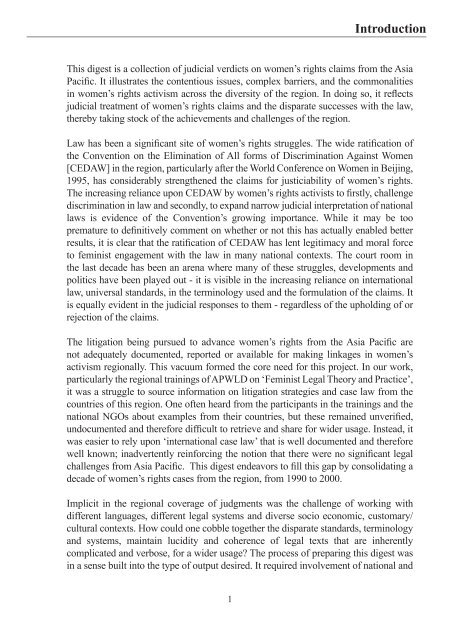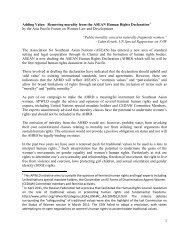A Digest of Case Law on the Human Rights of Women - Asia Pacific ...
A Digest of Case Law on the Human Rights of Women - Asia Pacific ...
A Digest of Case Law on the Human Rights of Women - Asia Pacific ...
Create successful ePaper yourself
Turn your PDF publications into a flip-book with our unique Google optimized e-Paper software.
Introducti<strong>on</strong><br />
This digest is a collecti<strong>on</strong> <str<strong>on</strong>g>of</str<strong>on</strong>g> judicial verdicts <strong>on</strong> women’s rights claims from <strong>the</strong> <strong>Asia</strong><br />
<strong>Pacific</strong>. It illustrates <strong>the</strong> c<strong>on</strong>tentious issues, complex barriers, and <strong>the</strong> comm<strong>on</strong>alities<br />
in women’s rights activism across <strong>the</strong> diversity <str<strong>on</strong>g>of</str<strong>on</strong>g> <strong>the</strong> regi<strong>on</strong>. In doing so, it reflects<br />
judicial treatment <str<strong>on</strong>g>of</str<strong>on</strong>g> women’s rights claims and <strong>the</strong> disparate successes with <strong>the</strong> law,<br />
<strong>the</strong>reby taking stock <str<strong>on</strong>g>of</str<strong>on</strong>g> <strong>the</strong> achievements and challenges <str<strong>on</strong>g>of</str<strong>on</strong>g> <strong>the</strong> regi<strong>on</strong>.<br />
<str<strong>on</strong>g>Law</str<strong>on</strong>g> has been a significant site <str<strong>on</strong>g>of</str<strong>on</strong>g> women’s rights struggles. The wide ratificati<strong>on</strong> <str<strong>on</strong>g>of</str<strong>on</strong>g><br />
<strong>the</strong> C<strong>on</strong>venti<strong>on</strong> <strong>on</strong> <strong>the</strong> Eliminati<strong>on</strong> <str<strong>on</strong>g>of</str<strong>on</strong>g> All forms <str<strong>on</strong>g>of</str<strong>on</strong>g> Discriminati<strong>on</strong> Against <strong>Women</strong><br />
[CEDAW] in <strong>the</strong> regi<strong>on</strong>, particularly after <strong>the</strong> World C<strong>on</strong>ference <strong>on</strong> <strong>Women</strong> in Beijing,<br />
1995, has c<strong>on</strong>siderably streng<strong>the</strong>ned <strong>the</strong> claims for justiciability <str<strong>on</strong>g>of</str<strong>on</strong>g> women’s rights.<br />
The increasing reliance up<strong>on</strong> CEDAW by women’s rights activists to firstly, challenge<br />
discriminati<strong>on</strong> in law and sec<strong>on</strong>dly, to expand narrow judicial interpretati<strong>on</strong> <str<strong>on</strong>g>of</str<strong>on</strong>g> nati<strong>on</strong>al<br />
laws is evidence <str<strong>on</strong>g>of</str<strong>on</strong>g> <strong>the</strong> C<strong>on</strong>venti<strong>on</strong>’s growing importance. While it may be too<br />
premature to definitively comment <strong>on</strong> whe<strong>the</strong>r or not this has actually enabled better<br />
results, it is clear that <strong>the</strong> ratificati<strong>on</strong> <str<strong>on</strong>g>of</str<strong>on</strong>g> CEDAW has lent legitimacy and moral force<br />
to feminist engagement with <strong>the</strong> law in many nati<strong>on</strong>al c<strong>on</strong>texts. The court room in<br />
<strong>the</strong> last decade has been an arena where many <str<strong>on</strong>g>of</str<strong>on</strong>g> <strong>the</strong>se struggles, developments and<br />
politics have been played out - it is visible in <strong>the</strong> increasing reliance <strong>on</strong> internati<strong>on</strong>al<br />
law, universal standards, in <strong>the</strong> terminology used and <strong>the</strong> formulati<strong>on</strong> <str<strong>on</strong>g>of</str<strong>on</strong>g> <strong>the</strong> claims. It<br />
is equally evident in <strong>the</strong> judicial resp<strong>on</strong>ses to <strong>the</strong>m - regardless <str<strong>on</strong>g>of</str<strong>on</strong>g> <strong>the</strong> upholding <str<strong>on</strong>g>of</str<strong>on</strong>g> or<br />
rejecti<strong>on</strong> <str<strong>on</strong>g>of</str<strong>on</strong>g> <strong>the</strong> claims.<br />
The litigati<strong>on</strong> being pursued to advance women’s rights from <strong>the</strong> <strong>Asia</strong> <strong>Pacific</strong> are<br />
not adequately documented, reported or available for making linkages in women’s<br />
activism regi<strong>on</strong>ally. This vacuum formed <strong>the</strong> core need for this project. In our work,<br />
particularly <strong>the</strong> regi<strong>on</strong>al trainings <str<strong>on</strong>g>of</str<strong>on</strong>g> APWLD <strong>on</strong> ‘Feminist Legal Theory and Practice’,<br />
it was a struggle to source informati<strong>on</strong> <strong>on</strong> litigati<strong>on</strong> strategies and case law from <strong>the</strong><br />
countries <str<strong>on</strong>g>of</str<strong>on</strong>g> this regi<strong>on</strong>. One <str<strong>on</strong>g>of</str<strong>on</strong>g>ten heard from <strong>the</strong> participants in <strong>the</strong> trainings and <strong>the</strong><br />
nati<strong>on</strong>al NGOs about examples from <strong>the</strong>ir countries, but <strong>the</strong>se remained unverified,<br />
undocumented and <strong>the</strong>refore difficult to retrieve and share for wider usage. Instead, it<br />
was easier to rely up<strong>on</strong> ‘internati<strong>on</strong>al case law’ that is well documented and <strong>the</strong>refore<br />
well known; inadvertently reinforcing <strong>the</strong> noti<strong>on</strong> that <strong>the</strong>re were no significant legal<br />
challenges from <strong>Asia</strong> <strong>Pacific</strong>. This digest endeavors to fill this gap by c<strong>on</strong>solidating a<br />
decade <str<strong>on</strong>g>of</str<strong>on</strong>g> women’s rights cases from <strong>the</strong> regi<strong>on</strong>, from 1990 to 2000.<br />
Implicit in <strong>the</strong> regi<strong>on</strong>al coverage <str<strong>on</strong>g>of</str<strong>on</strong>g> judgments was <strong>the</strong> challenge <str<strong>on</strong>g>of</str<strong>on</strong>g> working with<br />
different languages, different legal systems and diverse socio ec<strong>on</strong>omic, customary/<br />
cultural c<strong>on</strong>texts. How could <strong>on</strong>e cobble toge<strong>the</strong>r <strong>the</strong> disparate standards, terminology<br />
and systems, maintain lucidity and coherence <str<strong>on</strong>g>of</str<strong>on</strong>g> legal texts that are inherently<br />
complicated and verbose, for a wider usage? The process <str<strong>on</strong>g>of</str<strong>on</strong>g> preparing this digest was<br />
in a sense built into <strong>the</strong> type <str<strong>on</strong>g>of</str<strong>on</strong>g> output desired. It required involvement <str<strong>on</strong>g>of</str<strong>on</strong>g> nati<strong>on</strong>al and<br />
1



